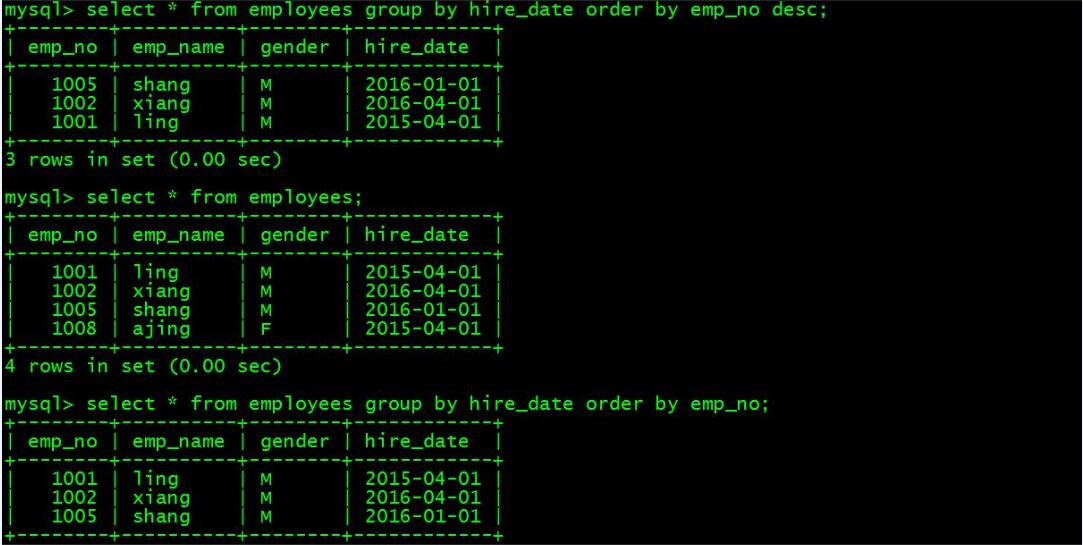首页 > 代码库 > MySQL常用操作
MySQL常用操作
MySQL常用操作
授权超级用户:
grant all privileges on *.* to ‘tangnanbing‘@‘%‘ identified by ‘1qaz@WSX‘ with grant option;
查看库:
show databases;
查看都有哪些库 show databases;
查看某个库的表 use db; show tables \G;
查看表的字段 desc tb;
查看建表语句 show create table tb;
当前是哪个用户 select user();
当前库 select database();
创建库 create database db1;
创建表 create table t1 (id int, name char(40) adress varchar(30));
char(10) ‘aaa ‘
varchar(10) ‘aaa‘
查看数据库版本 select version();
查看mysql状态 show status;
修改mysql参数 show variables like ‘max_connect%‘; set global max_connect_errors = 1000;
查看mysql队列 show processlist;
select * from information_schema.processlist where info is not null;
sleep的可以忽略,qurey查询的才有
创建普通用户并授权 grant all on *.* to databases1.user1 identified by ‘123456‘;
grant all on db1.* to ‘user2‘@‘10.0.2.100‘ identified by ‘111222‘;
grant all on db1.* to ‘user3‘@‘%‘ identified by ‘231222‘;insert into tb1 (id,name) values(1,‘aming‘);
更改密码 UPDATE mysql.user SET password=PASSWORD("newpwd") WHERE user=‘username‘ ;
查询 select count(*) from mysql.user; select * from mysql.db; select * from mysql.db where host like ‘10.0.%‘;
插入 update db1.t1 set name=‘aaa‘ where id=1;
清空表 truncate table db1.t1;
删除表 drop table db1.t1;
删除数据库 drop database db1;
修复表 repair table tb1 [use frm];
查看权限show grants for root@‘localhost‘;
echo "select user,host,password from mysql.user" |mysql -uroot -plingxiangxiang
mysql -uroot -p1234556 -e "select user,host,password into outfile ‘/home/mysql/1.txt‘ from mysql.user;"
;
增:insert into test.test (id, name) values (123, ‘ling‘);
insert into test.test values (value1_1, value2_2), (value2_1,value2_2), (value3_1, value3_2);
删:delete from test.test where id in (123, 456);
alter table test drop column dt;删除字段,test表,dt字段
改:update msyql.user set password = password(‘lingxiangxiang‘)
alter table employees add primary key (emp_no); 增加主键
alter table employees drop/add column salaries; 删除字段
create table blog_blogmodel as select * from book_blogmodel; 创建一样的新表
该表名:
查:select user, host, password from mysql.user where user = "root";
select * from msyql.user where conditions order by user [desc];
调整字段顺序:
ALTER TABLE `user_movement_log` CHANGE `GatewayId` `GatewayId` int not null default 0 AFTER RegionID
alter table test2 drop column cj, drop column goushi;
排序:select * from test.test order by id asc/desc;
SELECT * FROM usersWHERE email NOT REGEXP ‘^[A-Z0-9._%-]+@[A-Z0-9.-]+.[A-Z]{2,4}$‘
show global variables like ‘%read_only%‘;
alter user root@localhost identified by ‘‘;
导出:
select * into outfile ‘/tmp/test/users.txt‘ fields terminated by ‘<[!]>‘ lines terminated by ‘<[end]>‘ from users;
导入:
load data infile ‘/tmp/test/users.txt‘ into table gamedb.users fields terminated by ‘<[!]>‘ lines terminated by ‘<[end]>‘;
create index idx_name on salaries(emp_no); 创建salaries表的emp_no字段的索引
show index from salaries\G; 查看索引
日期常用格式:‘year-month-day‘
复杂语句:
select * from (select * from employees order by emp_no desc) aa group by hire_date ;
先对emp_no 进行反向排序,然后在把hire_date分组

内连接:join默认是inner
select * from employees inner join salaries on employees.emp_no = salaries.emp_no;

左外链接:右外链:
select * from employees left join salaries on employees.emp_no = salaries.emp_no;

select * from employees right join salaries on employees.emp_no = salaries.emp_no;

update的加强版
select * from employees;

UPDATE `employees`
SET emp_name = CASE emp_name
WHEN ‘ling‘ THEN ‘lingjing‘
WHEN ‘xiang‘ THEN ‘lingxiang‘
ELSE ‘wang‘
END
WHERE gender=‘M‘;

limit 1 :打印一行
max(emp_no): 最大
select max(emp_no) as emp_no from employees; max(emp_no)改成名字emp_no
问题三:内联结 + 非关联子查询
SELECT s1.article, `dealer`, s1.price
FROM `shop` AS s1
JOIN ( SELECT `article`, MAX(price) AS price
FROM `shop`
GROUP BY `article`
) AS s2
ON s1.article = s2.article
AND s1.price = s2.price
;
本文出自 “12350027” 博客,谢绝转载!
MySQL常用操作
